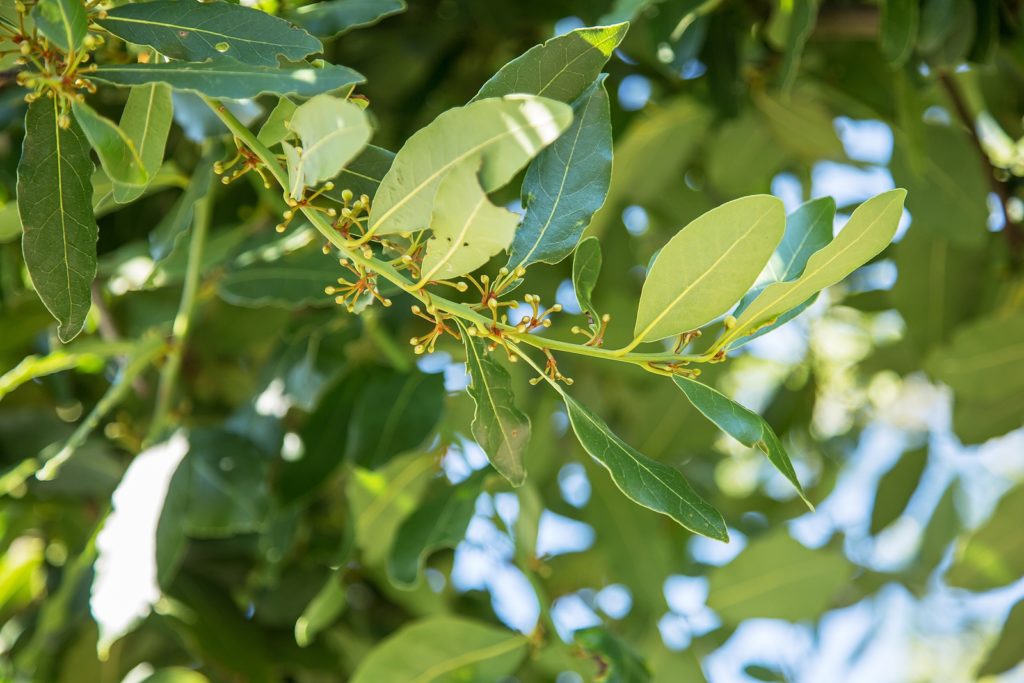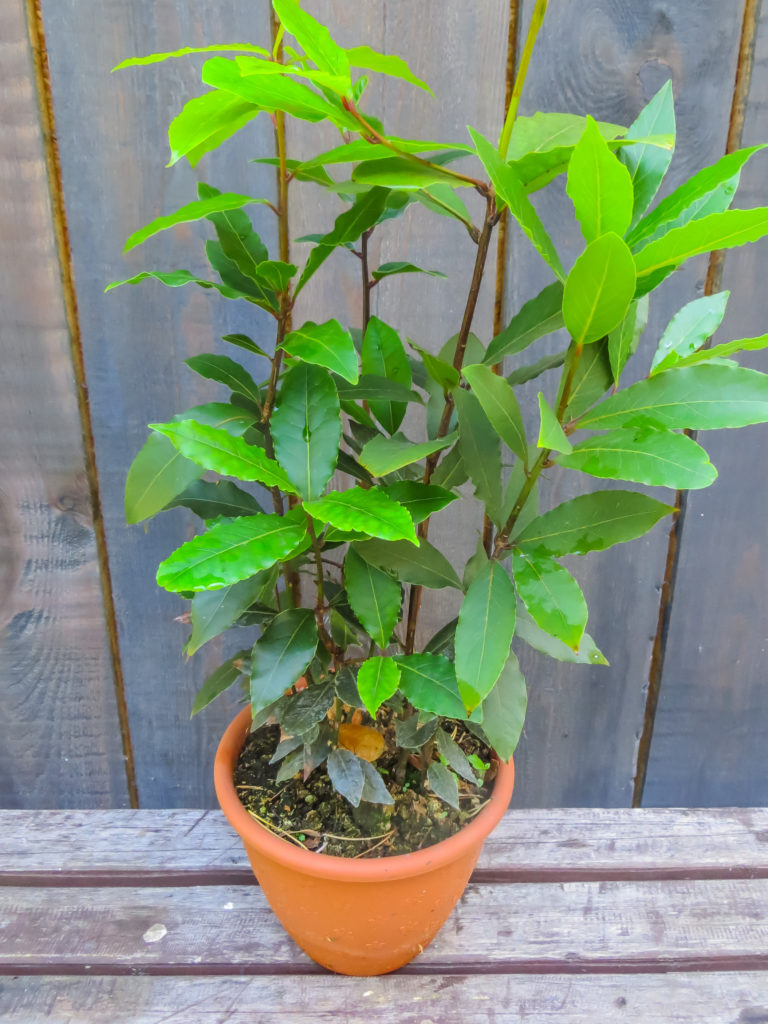Sweet bay is an aromatic herb that grows as a large shrub or tree. Bay leaves are used to flavor soups, stews, vegetables, and meats. Sweet bay is also called laurel leaf and bay laurel.
Here is your complete guide for growing sweet bay.
Where to plant sweet bay
- Best location: Plant bay in full sun in well-drained soil. Shelter bay from harsh winds. Bay is susceptible to frost and cold damage so grow plants in containers that can be moved indoors in cold-winter regions.
- Soil preparation: Bay grows best in humus-rich well-drained soil and prefers a soil pH of 6.2 to 6.6.

When to plant sweet bay
- Seed starting indoors: Propagate bay from cuttings or shoots in spring. The seed is slow to germinate; start seeds indoors any time of the year for transplanting out to the garden in spring.
- Transplanting to the garden: Set rooted bay plants in the garden in spring or summer.
- Outdoor planting time: Plant young bay trees in the garden in spring. You can purchase young bay trees in one, three, and five-gallon containers.
How to plant sweet bay
- Planting depth: Set container-grown plants at the depth they were growing in the pot, not deeper.
- Spacing: Bay trees will grow to 20 feet tall and half again as wide if allowed to grow to maturity. Space trees accordingly.
- How much to plant: One bay tree will supply all of your culinary needs.
Companion planting sweet bay
- Companion planting: Container-grown bay trees (single-trunked standards) can be surrounded by smaller annual herbs such as basil and thyme. Bay leaves are said to repel fleas, lice, and moths.
Watering and feeding sweet bay
- Watering: Keep the soil just moist, not wet, especially bay plants are getting established. Bay requires only occasional watering once established. Make sure the soil drains well and is never soggy or wet.
- Feeding: Fertilize bay in spring with an all-purpose organic fertilizer; sweet bay is a slow grower; do not over-fertilize bay. Aged compost is a good soil amendment and so is bone meal.
Sweet bay care and maintenance
- Care: Prune away growing tips to keep the plant bushy. Repot container-grown bay plants to larger pots every three years or so (or root prune the plant to stay in the smaller container). Keep bay healthy by showering the plant with water a couple of times a year.

Container growing sweet bay
- Container and winter growing: Bay plants grow 10 to 12 inches each year; a one-gallon plant will grow to about 5 feet tall in five years. You can keep container-grown bay pruned from 2 to 5 feet tall. Grow bay in a rich potting mix; transplant plants to larger pots as they grow. Container growing is the best course in cold-winter regions. Plants can be set outdoors from spring to fall and brought indoors during freezing weather. Indoors, over-winter bay in a warm, sunny spot away from cold drafts. Choose a container that can be moved on casters or on a wheeled dolly. Trim away roots from pot-bound plants and add a new organic potting mix to stimulate new growth.
Sweet bay pests and diseases
- Pests: Bay is susceptible to scale. Control scale with horticultural oil or remove scale with a cotton swab dipped in alcohol.
How to harvest sweet bay
- When to harvest: Pick bay leaves fresh all year round. Young leaves are the most flavorful.
- How to harvest: Cut mature bay leaves as needed with garden snips or scissors; mature leaves have the best flavor.
Sweet bay in the kitchen
- Flavor and aroma: Bay leaves impart a sweet, pungent flavor with hints of nutmeg, vanilla, and pine. Dried leaves are stronger flavored than fresh leaves.
- Leaves: Add whole fresh or dry leaves to soups, stews, tomato sauces, marinades, and long-cooked meats. Add leaves at the start of cooking. The best flavor will be imparted if leaves are cooked for 30 minutes or more; remove the leaves before serving. Overuse of bay can make a dish bitter. Add a pinch of ground bay leaf to stuffings, soups, or stews.
- Cooking: One bay leaf will flavor 1 gallon of soup. Mix one whole bay leaf with thyme and parsley to make a bouquet garni. Cooking does not soften the leaves. Leaves are very stiff with sharp edges and should be removed before serving. Do not eat bay leaves.
- Culinary complements: Use bay in combination with peppercorns, saffron, garlic, allspice, citrus, and prepared and dried mustards.
Preserving and storing sweet bay
- Drying: Dry bay leaves before you use them. Dry leaves in a warm, shady spot, not in full sun. You can set them loose on a tray or in a bowl or you can hang them in a mesh bag. If leaves begin to curl press them between two boards. You can also dry bay leaves in the microwave; place the leaves on paper towels for 1 to 3 minutes, checking them every minute to see if they have dried.
- Freezing: Leaves can be frozen and used later like fresh leaves. Freeze leaves in a sealed plastic freezer bag.
- Storing: Store dried bay leaves in an airtight container. Dried leaves will lose flavor after about a year.
Sweet bay propagation
- Grow bay from seed, cuttings, or transplanted suckers. It’s easiest to start with a 1 to 3-gallon plant purchased from the garden center; you can begin harvesting leaves the first year.
- Seed: Seeds are difficult to start. Keep the soil temperature at 75° Seeds may germinate in as few as 28 days but they sometimes can take up to a year to germinate.
- Cuttings: Taking cuttings from fresh green shoots. Cuttings can take 6 to 9 months to root; keep cuttings in moist soil.
Sweet bay varieties to grow
- Sweet bay or Laurus nobilis is grown for culinary use.
- California bay, Umbellularia californica, is a different plant; it has a strong, rank flavor and is not a substitute for sweet bay.
Get to know sweet bay
- Botanical name and family: Laurus nobilis is a member of the Lauraceae or laurel
- Origin: Bay is native to the Mediterranean.
- Type of plant: Bay is a woody evergreen perennial shrub or tree that can grow from 10 to 60 feet tall depending upon circumstances. It can be grown in a container from a seedling to 5 feet tall in about 5 years.
- Growing season: Bay is an evergreen perennial that can grow wherever temperatures are greater than 25°
- Growing zones: Zones 8 to 10.
- Hardiness: Bay is hardy to about 25°F in the ground; bay is less hardy if growing in a container. Bring container-grown bay indoors when temperatures near freezing.
- Plant form and size: Bay can grow as a multi-stemmed shrub or it can grow as a single or multi-trunked tree. Bay grows 5 to 20 feet tall in a container depending upon growing location and circumstance. Bay can grow to 60 feet tall in a garden or the wild. Bay often grows from several shoots or trunks; it can be pruned to one trunk.
- Flowers: Bay has small, inconspicuous, creamy yellow flowers that develop into dark purple-black berries from ½ to 1 inch around.
- Bloom time: Bay blooms in spring.
- Leaves: Bay has oval, leathery, glossy, dark green leaves that grow 2 to 4 inches long with slightly wavy margins growing alternately on branches. New growth is purplish-brown.
Learn how to plant, grow, and harvest your favorite kitchen herbs. Click below for all you need to know about culinary herbs.
- Anise
- Anise Hyssop
- Arugula
- Basil
- Bay
- Bee Balm
- Borage
- Calendula
- Caraway
- Catnip
- Chamomile
- Chervil
- Chives
- Cilantro-Coriander
- Clary
- Costmary
- Cress
- Dill
- Fennel, Sweet
- Horseradish
- Hyssop
- Lavender
- Lemon Balm
- Lemon Verbena
- Lovage
- Marjoram
- Mint
- Nasturtium
- Oregano
- Parsley
- Perilla
- Rosemary
- Sage
- Salad Burnet
- Savory
- Scented Geranium
- Shiso
- Sorrel
- Stevia
- Sweet Cicely
- Tarragon
- Thyme
Also of interest:
Related articles:
Best Herbs for Container Growing
Planning the Home Fruit Garden
Garden Planning Books at Amazon:
- Vegetable Garden Almanac & Planner
- Kitchen Garden Grower’s Guide Vegetable Encyclopedia
- Vegetable Garden Grower’s Guide
- Tomato Grower’s Answer Book















